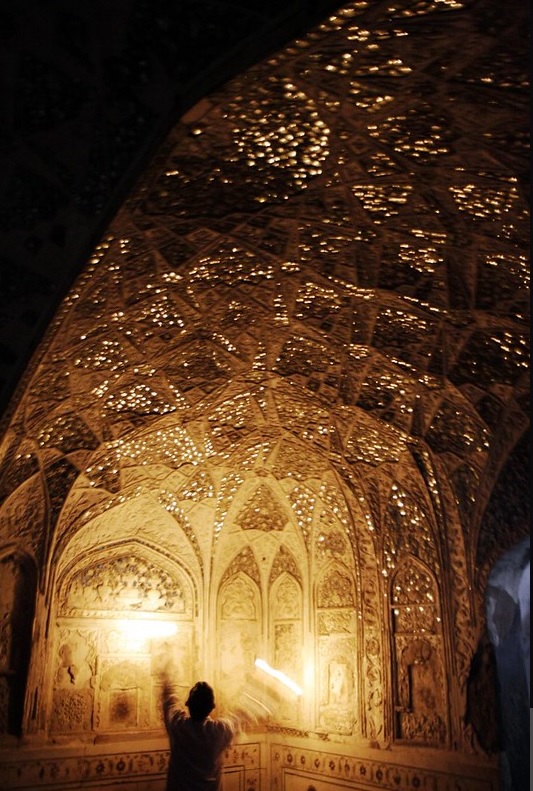FWP:
SETS
JALVAH: {7,4}
MIRROR: {8,3}
SUN verses: {3,14x}; {10,5}; {24,3}; {38,2}: {61,1}; {62,8}; {67,1}, on the 'crack of dawn'; {68,4}; {74,1}; {78,5}; {81,7x}; {87,3}; {95,3}; {97,11}; {105,2}; {110,6}; {113,6}; {115,3}; {124,3}; {128,1}; {138,2}; {152,1}; {154,7x}; {174,1}; {190,8}; {194,4}; {230,9} // {246x,6}; {264x,4}; {286x,1}; {299x,3}; {303x,5}; {305x,6}; {306x,5}; {307x,4}; {312x,4}; {320x,4}; {321x,3}; {344x,2}; {354x,3}; {355x,1}; {364x,7}; {365x,2}; {376x,3}; {376x,6}; {378x,1}; {380x,4}; {405x,6}; {421x,4}
ABOUT THE 'MIRROR-CHAMBER': See below.
The sun striking a field full of dewdrops makes every single drop glitter; the dazzle of the beloved's glory would light up a roomful of mirrors. Then instantly the sun vaporizes the dewdrops into nothingness; the beloved's radiance would perhaps even cause the mirrors themselves to melt with shame at their own inability to capture and display such beauty.
The word for 'dew', shabnam , literally means 'night-moisture'-- and thus concisely evokes exactly the two conditions always banished by the the sun.
I thank my student Avni Majithia for alerting me (Mar. 2009) to the full possibilities of the apparently awkward grammar in the second line. After meditating on her well-thought-out objections both to the commentators and to my own previous reading, I've come up with this as a prose order:
tire jalve ne aa))iinah-;xaane kaa vuh naqshah kiyaa
jo ((aalam partav-e ;xvurshiid shabnam-istaa;N kaa kare
your glory made of the mirror that picture/condition [vuh naqshah]
which situation [jo ((aalam] a ray of the sun would make of a land of dew
On this reading, naqshah and ((aalam are being treated not necessarily as identical, but as referring to the same situation. The awkwardness comes because the jo and the ((aalam are placed so far apart in the line; but other readings become awkward in different ways, so it's really only a question of which kind of awkwardness we choose.
As another way of dealing with the awkwardness, some people want to read the second line with an i.zaafat after ;xvurshiid . Arshi doesn't show such an i.zaafat , but there's no metrical reason one can't be put in there. It would result in 'a ray of the sun of the world' creating the naqshah referred to in the first line 'out of a land of dew'. At first I was inclined to think that then the phrase 'of the world' would be mere padding, because we already know that about the sun. But then I realized that the beloved could be considered the sun of her own mirror-chamber realm, just as the outward sun is the sun of the dew-field realm. So that meaning too takes us in new directions (though I still think it a secondary one).
Are naqshah and ((aalam meant to be taken as (virtually) identical, or as significantly different? As usual, Ghalib has left us to decide for ourselves: their meanings have real overlaps, but also real differences (see the definitions above).
ABOUT THE 'MIRROR-CHAMBER': A 'mirror-chamber' ( aa))iinah-;xaanah ) is one of those mostly windowless 'Shish Mahal' [shiish-mahal] rooms that exist in many Mughal and Rajput palaces, with walls and ceilings tiled with small variously angled inlaid mirror fragments, or shiny glass or mirrored tiles, so that a torch or even a candle carried into the room creates a series of shifting, dancing, endlessly self-reflecting flashes of radiance. Other evocations of a 'mirror-chamber': {12,4x}; {16,6x}; {82,2x}; {104,3x}; {190,4}; {217,3} // {241x,5}; {258x,8}; {281x,4}; {341x,2}. How does it compare with the ornamental 'mirror-binding' in {246x,6}? It's hard to tell.
Compare Mir's more abstract mirror-chamber: M{190,3}.
Here's a view of the Agra Fort's shiish-mahal , dramatically lighted for visitors by a guide:

Nazm:
That is, the way dew cannot endure before the sun, the mirror cannot endure your glory. (11)
== Nazm page 11